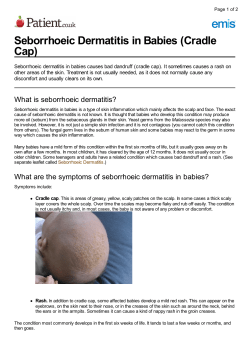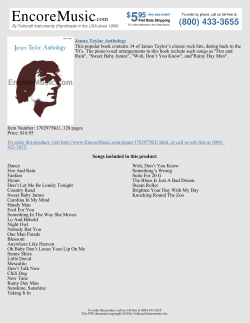
Cradle Cap
Cradle Cap Cradle cap is a skin condition that affects babies. It causes yellow, thick crusts on the scalp. It is extremely uncommon after a baby is three months old. It is a form of dermatitis, which causes inflammation of sebaceous (oil) glands in the skin. This type of dermatitis is called 'seborrhoeic dermatitis'. These glands help waterproof the skin by making a slightly greasy substance called sebum. Babies are born with active oil/sebaceous glands because they have been living in the mother's hormonal environment (ie.in the womb). Once a baby is about three months old, the oil/sebaceous glands become inactive until puberty. Cradle cap usually clears by itself after a few months but many parents prefer to remove it because they do not like the look of it. Scaly patches on the face or other parts of the body are not cradle cap and need to be checked by your doctor. If the dermatitis continues after your baby is three months old, it may be a sign of eczema and needs different treatment. Cradle cap is not painful or contagious and it is not caused by poor hygiene. Signs The signs of cradle cap include: • reddening of the skin • greasiness • scales or flakes on the scalp • yellow crusts Home treatment Cradle cap usually gets better on its own without treatment. The following may help it improve faster: • Loosen the crusts by massaging the scalp with mineral oil (like Baby Oil) at night. Wash the hair with a baby shampoo the next morning, gently lifting the crusts off with a soft brush (a soft toothbrush can be good for this). Try this each day until your baby's scalp looks clearer. • Use a mild anti dandruff shampoo for a limited time if the other treatment is not working - do be careful, these shampoos can irritate a baby's eyes more than shampoos specifically made for babies. • If it is continuing after your baby is three months old and/or it is very itchy for your baby, it may actually be eczema of the scalp. If this is the case, shampoos and salicylic acid creams will make it worse. The cradle cap may come back, even when treated properly, because the glands can still go on making too much sebum for a few months. 12/03/2010 02:41:27 AM Cradle Cap - RCH Fact Sheet 1/3 Infection and cradle cap Sometimes the skin under the crusts of cradle cap can become infected. The skin becomes redder and small blisters appear and then pop and weep. This is caused by the same germs that cause impetigo (school sores). If this infection spreads or your baby becomes unwell, make sure that you have your baby checked by a doctor. Your baby may need antibiotics to get rid of the infection. Unlike cradle cap, impetigo is contagious. When to get help If your baby's cradle cap isn't getting better or seems to be spreading to other areas of the body - including the face and body, speak to your family doctor, local chemist or maternal and child health nurse. Ongoing skin problems A baby who develops cradle cap may have other types of seborrhoeic dermatitis as they grow up, including persistent dandruff. Adolescence can be a peak time for seborrhoeic dermatitis because of increased production of sex hormones. Antifungal treatments may help. Key points to remember • Cradle cap is a form of dermatitis that affects some babies in their first few months of life. • Signs include greasy, yellow crusts on the scalp. • Massage of the scalp at night with a mineral oil or olive oil followed by washing the hair and scalp next morning, lifting the crusts with a soft brush may help. For more information Speak to your: • Family doctor • Local chemist or • maternal and child health nurse • Visit www.betterhealth.vic.gov.au The content for this fact sheet has been written in consultation with the Departments of General Paediatrics and Dermatology. First published in May 2007. Updated November 2010. Disclaimer: The information contained on the site is intended to support not replace discussion with your doctor or health care professionals. The authors accept no responsibility for any inaccuracies, information perceived as misleading, or the success of any treatment regimen detailed in the handouts. 12/03/2010 02:41:27 AM Cradle Cap - RCH Fact Sheet 2/3 More RCH Fact Sheets can be found at www.rch.org.au/kidsinfo/. Last Updated 25-Nov-2010. Authorised by: Susan Jury. Enquiries: Judith Smith. ©RCH. http://www.rch.org.au 12/03/2010 02:41:27 AM Cradle Cap - RCH Fact Sheet 3/3
© Copyright 2025




















